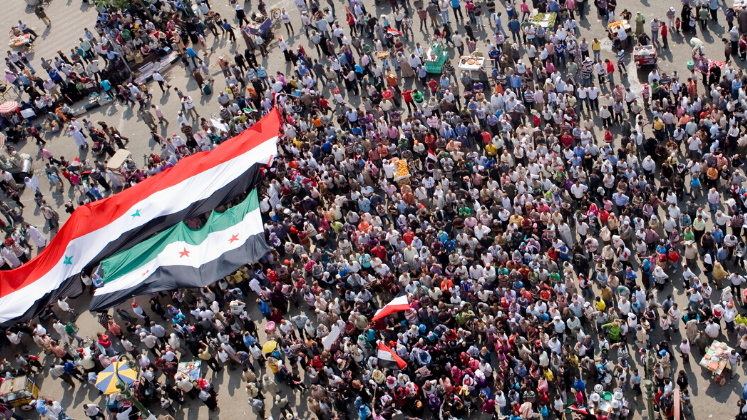In Egypt Under El-Sisi: A Nation on the Edge, Maged Mandour challenges simplistic views of the aftermath of the Egyptian revolution in 2011, when mass protests against the government forced then-president Ḥosnī Mubārak to step down. Mandour examines power shifts and the military’s consolidation of authority over the past decade of Abdel Fattah El-Sisi’s presidency, offering a nuanced intervention on post-revolutionary Egypt’s socio-political dynamics, writes Hesham Shafick.
Egypt Under El-Sisi: A Nation on the Edge. Maged Mandour. Bloomsbury. 2024.
 It takes me by surprise that we have already passed the 13th anniversary of Egypt’s revolution on January 25th 2011. Many theories and scholarly prints have been produced that try to make sense of how things unfolded after that day. The rise and fall of a structural “revolutionary situation”, the interplay between key local power centres, changing global dynamics, the or simply the work of talented tricksters are some of the many explanations proffered. Notwithstanding their differences, they all have one thing in common: singling out an external villain, a counterrevolutionary force(s), which mustered enough authority to override a once hopeful revolution.
It takes me by surprise that we have already passed the 13th anniversary of Egypt’s revolution on January 25th 2011. Many theories and scholarly prints have been produced that try to make sense of how things unfolded after that day. The rise and fall of a structural “revolutionary situation”, the interplay between key local power centres, changing global dynamics, the or simply the work of talented tricksters are some of the many explanations proffered. Notwithstanding their differences, they all have one thing in common: singling out an external villain, a counterrevolutionary force(s), which mustered enough authority to override a once hopeful revolution.
In Egypt Under El-Sisi: A Nation on the Edge, Maged Mandour refutes such a presumption of a dramatic distinction between victims and villains, revolutionaries and counterrevolutionaries. In doing so, he joins a cluster of critical thinkers, led by Gramscian political economists Brecht de Smet and Roberto Roccu, who stress the analytical necessity of understanding revolutions as “war(s) of positions” in which multiple actors exchange seats – be these ideologies, cultural codes, or political power – to formulate a new hegemonic, or “semi-hegemonic”, order. This reading paves the way for an understanding of the “post-revolution” collapse as a product of the revolutionary repertoire itself.
Mandour joins a cluster of critical thinkers […] who stress the analytical necessity of understanding revolutions as ‘war(s) of positions’ in which multiple actors exchange seats […] to formulate a new hegemonic, or ‘semi-hegemonic’, order.
In my own work, I took a cue from such thinking to co-author a series of articles that reconceived of the January 25th movement as a moment that brought together a working class motivated by their socioeconomic grievances, a middle class motivated by liberal aspirations, and a military elite motivated by their greed (see “A fascist history of the Egyptian revolution” I, II, & III). These were all temporarily assembled to push back against a malignantly growing police state. The first day of protests was thus selectively chosen to be the policy holiday – January 25th.
After three days of street fighting, the police were forced to retreat. And since then, Tahrir and other protest squares turned into physical assemblies of the three participating sections of society. But it did not take long for the middle class and military to override the working class. The workers’ demands were sidelined, even vilified, as “fractional” and “divisive”, facilitating a popularly backed military crackdown on factory protests. That was in the very early days of the revolution, a few months after the police retreat. Immersed in the utopian moment of overthrowing the police state, the middle class failed to observe the emergence of an even more dangerous armed regime, one which is far more powerful and, ironically because of their backing of the revolution, or more precisely its middle-class pillar, more popular.
Immersed in the utopian moment of overthrowing the police state, the middle class failed to observe the emergence of an even more dangerous armed regime
This re-conception of the post-revolution military regime – led by former minister of defence and head of military intelligence President Abdel Fattah El-Sisi – as a product of the revolutionary repertoire, rather than an independent counterforce, is, we argued, a game changer to analysts and activists alike. For if Sisi’s regime is a counterrevolutionary junta that overthrew the revolutionary movement by force, then the revolutionary response should be straightforward: keep pushing! It is therefore crucial to understand the nature of such a regime in relation to the revolution, not only to make sense of the startling concurrence of seemingly contradictory popular chants like “ya geshna enzel ehmina” [Oh our Army, rise and protect us] and “Yasqot Yasqot hom el ‘askar” [down, down with the military regime] in the same protest, but also to determine the strategies that can produce revolutionary outcomes in such a peculiar context.
Mandour does not focus on the January 25th revolution, but rather Sisi’s regime as a product of a prolonged of which January 25th and its ensuing coup regimes of 2011 and 2013 were mere symptoms.
It is from this lens that I welcomed Mandour’s account with excitement. Mandour does not focus on the January 25th revolution, but rather Sisi’s regime as a product of a prolonged of which January 25th and its ensuing coup regimes of 2011 and 2013 were mere symptoms. Passive revolution refers to an ongoing sociopolitical process where dominant elites keep maintaining their control through selective and temporary co-optations with variant classes, each of which eventually wind up pacified and sidelined. In this account, the revolution, the military regime, and their temporary coalition under Sisi’s rule, were a continuity of social reshuffles that attempted to constitute a political order in the vacuum created after the collapse . (For more on post-Nasser hegemonic vacuum, see Sarah Salem’s Anticolonial Afterlives in Egypt, reviewed here.)
In 1967, Mandour explains, Nasser not only lost his war with Israel on the Sinai Peninsula; he lost the package of ideological promises of Pan-Arabism, Arab-Socialism and postcolonialism that built his mandate. However, some of this regime’s structural legacies remained intact: military supremacy, a police-hijacked state, and a de-politicised middle class. Emptied of their ideological enablers, three social clusters found themselves in a power scramble, in which “soldiers, spies, and statesmen” – as Hazem Kandil eloquently puts it – would every now and then “solicit mass popular support” to leverage one of the three actors over the others (85).
Fast-forward to Egypt Under El-Sisi: the same actors remain at play, now producing a different type of regime. In 2013, Sisi rose to the fore with a promise to bring back the “unity” of the Egyptian middle class, popularly perceived to be disrupted by the rise of the Muslim Brotherhood in the aftermath of January revolution. Here, “unity” is conceived of as “sameness” and hence disrupted by the appearance of that was for so long forcefully kept at the margins, even officially abandoned from political participation – the Muslim Brotherhood (55). Utilising the popular frustration caused by this disruption, Sisi garnered the support of the middle class through a very simple promise: returning the national identity; in other words, getting rid of the Muslim Brotherhood.
The first post-coup regime was headed by middle-class technocrats with the military pulling strings behind the scenes.
The first post-coup regime was headed by middle-class technocrats with the military pulling strings behind the scenes. This arrangement was, however, far from stable. As Niccolo Machiavelli has stated: “there is nothing proportional between the armed and the unarmed; and it is not reasonable that he who is armed should yield obedience willingly to him who is unarmed.” Realising that, the military apparatus, spearheaded by Sisi himself, administrated a crackdown on its middle-class power-sharers, crushing contenders and allies alike. It did so through multiple means, articulately described in Egypt under El-Sisi, which fall under three mutually reinforcing policy categories – legalisation of repression, displays of bloodshed, and the military capture of the economy. Repressive laws were passed with a violent state crackdown on any public dissent. This facilitated further violence by granting it a legalised status. In turn, this dynamic granted the military both the legal and the armed control over the most lucrative markets within the Egyptian economy, which further enhanced the officers’ loyalty to the regime, facilitating further violence. Such a vicious cycle eventually led to the middle-class becoming, once again, sidelined; this time with no other significant regime actors at play, and hence no need for co-opting any social class whatsoever. The result was, Mandour describes, a first of its kind military dictatorship that feels no political obligation towards any other actor; neither security partners nor any social class – no spies, no statesmen, just soldiers.
Egypt Under El-Sisi claims to be a narrative of the rise of a military dictatorship and the demise of the traditional post-Nasserist liberal autocracy. But the book’s relevance goes far beyond that, especially to students of Gramsci and post-Marxist critical thought.
Egypt Under El-Sisi claims to be a narrative of the rise of a military dictatorship and the demise of the traditional post-Nasserist liberal autocracy. But the book’s relevance goes far beyond that, especially to students of Gramsci and post-Marxist critical thought. The book’s analysis of post-January 25th politics in Egypt points to an exceptional form of “passive revolution” which has no class of beneficiaries other than the military itself. Its structural arrangement looks like a product of a typical military coup, except that it is not. In fact, the regime outset, always relied on popular mobilisation, despite the absence of the mobilised class and its agenda from all aspects of policymaking.
That is the main question the book leaves us with, one that encourages further empirical research, but also conceptual enquiry into the possibility of a semi-hegemonic arrangement that lacks not only ideological underpinnings, but even structural foundations. No doubt, the starting point for such an analysis would be Gramsci’s “passive revolution”, but how could this revolution be possible without a class of beneficiaries? Perhaps the answer lies beyond the structural analysis Gramscian paradigms proffer, and one should rather look into superstructural instruments by which the masses could be deceived to recurrently act against their best interest.
This post gives the views of the author, and not the position of the LSE Review of Books blog, or of the London School of Economics and Political Science.
Image Credit: mehmet ali poyraz on Shutterstock.






